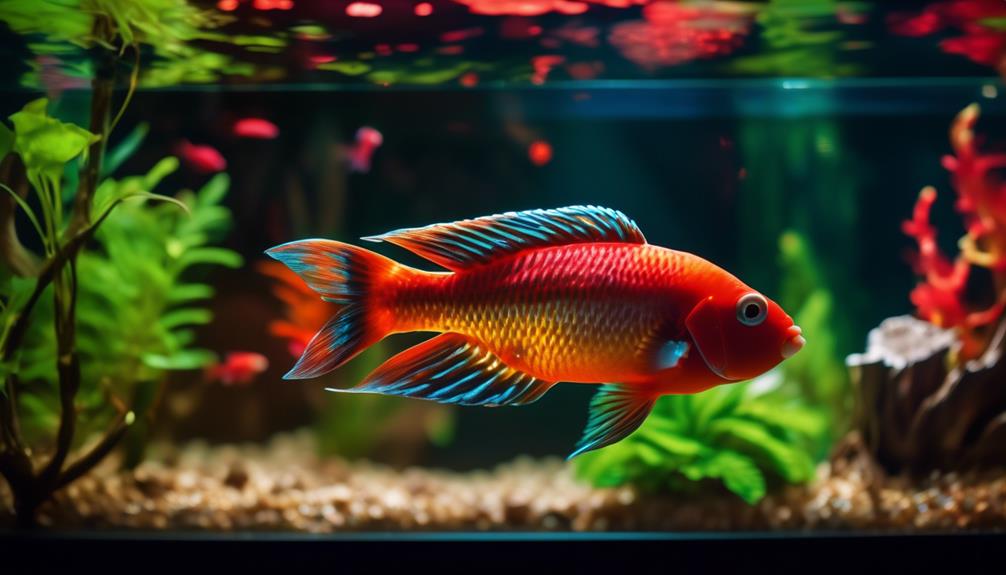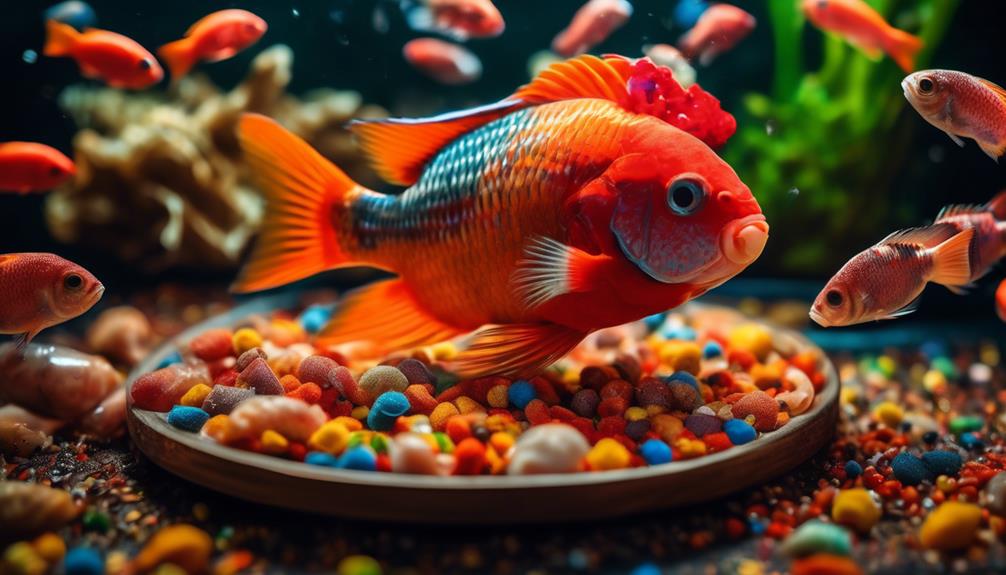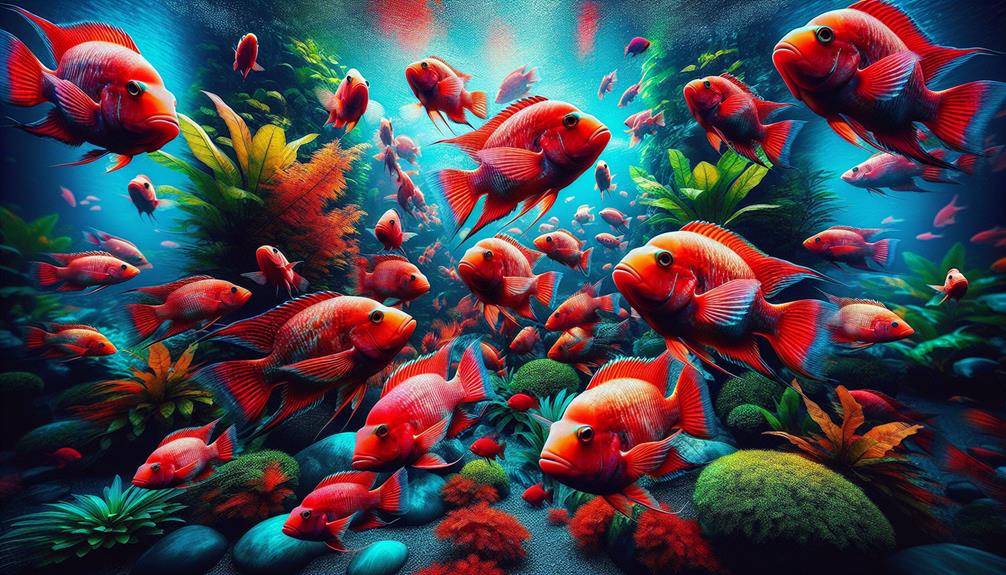Welcome to the intriguing world of Blood Parrot Cichlids, where fierce beauty meets vibrant colors. These captivating creatures, with their rounded heads and unique deformities, have captured the hearts of aquarium enthusiasts worldwide.
In this comprehensive guide, we will delve into the origins and characteristics of Blood Parrot Cichlids, uncovering the fascinating story behind their hybridization.
But that's not all – we'll also explore the various types and color variations of these cichlids, revealing the stunning array of hues they can exhibit.
So, whether you're a seasoned aquarist or new to the hobby, get ready to embark on a journey that will leave you captivated and eager to learn more about these fierce and colorful creatures.
Key Takeaways
- Blood Parrot Cichlids are a hybrid fish developed in Taiwan from a mix of Central American cichlids.
- They can grow up to 8 inches long and have rounded heads and small, deformed mouths.
- There are various color variations of Blood Parrots, including blood red, red and white, yellow, and purple.
- Blood Parrots require specific tank sizes and setups to accommodate their needs and reduce aggression.
Origins and Characteristics
The Blood Parrot Cichlid is a captivating fish known for its unique appearance and vibrant colors. It originated in Taiwan through the hybridization of various Central American cichlid species, such as the Midas cichlid, Redhead cichlid, and Red devil cichlid.
These fish can grow up to 8 inches long and have rounded heads with small, deformed mouths. They come in various color variations, including blood red, red and white, yellow, and purple. Additionally, hybridization with other cichlids has resulted in the creation of King Kong, platinum, polar blue, and kirin parrot cichlids.
However, breeding and reproductive behavior can be challenging due to their deformed mouths. Common health issues include swim bladder problems, skin infections, and digestive issues. Proper care requires maintaining suitable water parameters, providing a balanced diet, and monitoring for any signs of illness.
Types and Color Variations
After exploring the origins and characteristics of the Blood Parrot Cichlid, it is essential to delve into the fascinating world of its types and color variations. Through selective breeding techniques, breeders have been able to develop a wide range of color variations in Blood Parrot Cichlids. These variations include blood red, red and white, yellow, and purple, among others.
Furthermore, genetic mutations have allowed for the creation of hybridized variations such as the King Kong, platinum, polar blue, and kirin parrot cichlids. The color of these cichlids can range from vibrant reds to striking yellows. With crossbreeding, breeders continue to produce more unique and diverse varieties of Blood Parrot Cichlids.
These stunning color variations and genetic mutations contribute to the allure and beauty of these fish in the aquarium trade.
Setting Up the Perfect Aquarium

To create an optimal environment for Blood Parrot Cichlids, careful consideration must be given to the setup of the aquarium. This includes choosing the right filtration system and creating a natural and visually appealing habitat.
Choosing the right filtration system is crucial for maintaining water quality and providing a healthy environment for the fish. A canister filter is recommended due to its high capacity for mechanical, chemical, and biological filtration. It helps remove debris, excess nutrients, and harmful substances from the water, ensuring the well-being of the Blood Parrot Cichlids.
Creating a natural and visually appealing habitat is essential for the overall well-being and happiness of the fish. It is recommended to include live plants, rocks, and driftwood to mimic their natural habitat. This provides hiding places and territories for the fish, reducing stress and promoting their natural behaviors.
Additionally, adding a substrate like sand or gravel will help create a more natural environment and facilitate bottom-dwelling behaviors.
Finding Compatible Tank Mates
Continuing our exploration of Blood Parrot Cichlid care, let's now turn our attention to the important task of finding suitable tank mates for these unique and vibrant fish. Tank mate compatibility is crucial for a harmonious aquatic environment. When dealing with aggression, it's essential to select companions that can coexist peacefully with the Blood Parrot Cichlids.
Here are three potential tank mates that have shown compatibility with Blood Parrot Cichlids:
- Oscars: These large and robust cichlids are known for their resilience and ability to hold their ground. They can withstand the occasional aggressive behavior of Blood Parrot Cichlids.
- Angelfish: With their graceful appearance and peaceful nature, angelfish make excellent companions for Blood Parrot Cichlids. Their similar size and temperament create a harmonious tank environment.
- Larger Tetras: Species such as Buenos Aires tetras or Red Eye tetras can coexist peacefully with Blood Parrot Cichlids. They add a splash of color and dynamic activity to the tank without triggering aggression.
Feeding and Nutrition Tips

When it comes to the feeding and nutrition of Blood Parrot Cichlids, it is important to understand their dietary requirements and provide them with suitable food options. These cichlids have specialized feeding habits due to their small, deformed mouths. Their triangular-shaped mouths are better suited for scooping rather than biting. To ensure their nutritional needs are met, it is recommended to feed them baby-sized pellets when they are juveniles and switch to mini pellets as they grow into adults. Floating pellets work best as they can be easily scooped from underneath. Additionally, there are blood parrot-specific foods available in the market that contain color-enhancing ingredients to maintain and enhance their vibrant hues. This specialized food options help meet their unique feeding requirements and promote their overall health and well-being.
| Feeding Habits | Specialized Food Options |
|---|---|
| Small, deformed mouths | Baby-sized pellets for juveniles |
| Triangular-shaped mouths | Mini pellets for adults |
| Scooping rather than biting | Floating pellets |
| Color-enhancing ingredients | Blood parrot-specific foods |
Frequently Asked Questions
How Long Do Blood Parrot Cichlids Typically Live?
The average lifespan of blood parrot cichlids is typically around 10-15 years, although some individuals have been known to live up to 20 years. When selecting tank mates for blood parrots, it is important to consider similar-sized and peaceful or semi-aggressive species.
Can Blood Parrot Cichlids Be Kept in a Community Tank With Other Fish?
Blood parrot cichlids can be kept in a community tank with other fish, but caution is advised due to their aggressive behavior. Compatible tank mates should be similar in size and temperament, while avoiding small-mouthed species.
Do Blood Parrot Cichlids Require Any Special Care or Maintenance?
Blood parrot cichlids require special care and maintenance. They need a suitable tank setup with appropriate temperature and pH levels. Additionally, their special diet should consist of easily swallowed pellets and color-enhancing ingredients.
Are Blood Parrot Cichlids Prone to Any Specific Diseases or Health Issues?
Blood parrot cichlids are prone to several common health issues and diseases. These include swim bladder disorders, skin infections, and parasitic infestations. Proper tank maintenance, water quality, and a balanced diet can help prevent these issues.
Can Blood Parrot Cichlids Be Kept in Outdoor Ponds or Are They Strictly Indoor Fish?
Blood parrot cichlids are typically kept in indoor tanks rather than outdoor ponds. This is due to their specific temperature and pH requirements, as well as the need for controlled environments to prevent potential harm or escape. Keeping them indoors allows for better monitoring and care.
Conclusion
In conclusion, Blood Parrot Cichlids are captivating creatures with a rich lineage and vibrant color variations. Understanding their origins, characteristics, and ideal aquarium setup is crucial for their well-being. By providing suitable tank mates and a balanced diet, aquarists can ensure the health and vitality of these remarkable fish.
As we dive deeper into the world of Blood Parrot Cichlids, one can't help but wonder: How does the interplay of their fierce colors and unique traits create a stunning visual spectacle in the aquarium?

